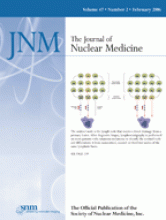TO THE EDITOR: The invited perspective of Mariani et al. (1) and the article of Classe et al. (2) deal with intraoperative radioguided surgery, especially in sentinel lymph node detection. Without doubt, the principal characteristics of a high-performance intraoperative γ-probe in terms of sensitivity, spatial resolution, energy resolution, shielding, and practical handling are presented and summarized qualitatively in Table 1 of the invited perspective of Mariani et al. (1). Nevertheless, these articles lead us to make the following remarks and question 2 particular points.
In our definition, spatial resolution is directly related to the open diameter of the probe, which roughly defines the solid angle of detection. Mariani et al. (1) claim that a semiconductor probe certainly has a higher spatial resolution than a scintillator probe. This statement is strongly affirmed on 2 occasions, although the arguments on which this affirmation is based are not clear. Perhaps it is supported by the spatial resolution values quoted in Table 1 of the article of Classe et al. (2), which reports that a spatial resolution of 3 mm was reached with a probe having a 14-mm diameter. We believe that this is a printing error. In the interest of clarity, it is important that the authors provide the complete definition used for their so-called spatial resolution.
It is also not obvious to us that the electronics associated with a semiconductor probe are simpler than the electronics needed by a photodetector coupled to a scintillation crystal. Arguments have to be developed to support this statement.
As a contribution to the answer of the question expressed in the title of the invited perspective of Mariani et al. (1), we propose to shortly present results of our own work in the field of radioguided surgery. The Subatomic Research Institute in Strasbourg, France (http://wwwires.in2p3.fr/ires/imabio), has developed a prototype scintillator probe named CarolIReS, based on the quickly decaying yttrium aluminum perovskite activated by a cerium (YAP:Ce) crystal of 4-mm diameter. A γ-ray counter with a geometric efficiency of 26% ± 6% was used to obtain the values of the total remaining activity of 20 sentinel lymph nodes at the time of their resection. The rate of events detected by the CarolIReS probe belonging to the 99mTc energy window selection was measured ex vivo on contact with these sentinel lymph nodes. When these 2 measurements are combined, the mean counting efficiency is evaluated to be 18.1 (2.1–100.0) cps·kBq−1. The spatial resolution measured with 2 sources located 10 mm from the probe head is 8 mm in full width at half maximum. Despite the high scintillation light yield of the crystal (1.8 × 104 photons·MeV−1), the low-energy resolution of 56% for 140-keV γ-rays is primarily due to the loss of light occurring in a quartz light guide placed between the crystal and the photocathode of the photomultiplier. The linearity in energy has been tested up to 511 keV. The optimized shielding has allowed the identification of an intramammary sentinel lymph node localized near the injection points (3). The electronics developed to process fast signals allow us to also equip the probe with other high-density and high-scintillation-yield crystals such as lutetium yttrium orthosilicate.
In summary, the affirmations of Mariani et al. (1) that semiconductor probes are characterized by higher spatial resolution than scintillator probes and that the electronics connected to semiconductor probes are simpler than the electronics connected to scintillation crystal are open to debate.







